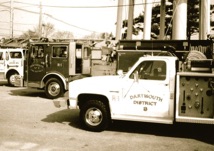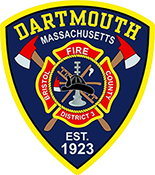ABOUT US
POPULATION: 18,000
FIRE PROTECTION DISTRICT: 32 SQ MILES
PERSONNEL: 42
2024 Reponses: 1084
Dartmouth Fire District 3 was established in 1923 to provide fire protection to the northern half of the Town of Dartmouth. The Fire District is a separate and distinct, special municipality from the Town of Dartmouth. The district protects the largest portion of the Town's commercial, industrial, medical, and mixed-use occupancies. Numerous State facilities are protected by the district including the University of Massachusetts Dartmouth and the Bristol County Jail. The district is traversed by Interstate Highway 195, State Highway Route 6, the Bay Colony Railroad, and the Algonquin Gas high pressure Transmission pipeline.
The fire department is an all-hazards emergency response agency with a highly trained and dedicated workforce of professional fire and emergency medical personnel. Providing fire suppression, technical rescue, hazardous materials, and emergency medical response with a class V non-transport ambulance. The department reduces the need for these services through various programs including fire safety education, plans review, permitting, code enforcement, and in building fire alarm monitoring. Additionally, the district provides car seat installations and checks, smoke and carbon monoxide detector installations, residential key lock boxes, and address signs for our senior population.

Fire Station Locations
Station 1 at 140 Cross Road
It is equipped with a pumper truck, ladder truck, forestry truck, and rescue truck.
Station 2 at 1140 Hixville Road
It is equipped with two pumpers, a tanker, and a forestry truck.
Station 3 at 254 State Road
It is equipped with a pumper and a mini-pumper.
Personnel
The fire department is comprised of 12 full-time Firefighter EMTs, 25 paid-on-call Firefighter EMTs and First Responders, a full-time Captain, a full-time Deputy Chief, a full-time Fire Chief and a full-time Senior Administrative Assistant.
Annual Meetings
Annual meetings allow voters to approve a general policy, budget, and capital outlay. The District is financed by property taxes levied by the Fire District meetings.
OUR HISTORY
In 1652, thousands of acres of land in the Southeastern region of Massachusetts, belonging to the Wampanoag Indians, was purchased by a group of Plymouth colonists and named after the English seaport of Dartmouth, England. At the time, the purchase included the surrounding towns of Acushnet, Fairhaven, New Bedford, and Westport.
 Dartmouth’s corporate existence, however, began twelve years later, in 1664. It wasn’t until 1674 that the Town established a form of government of a Town Meeting by elected officials; the same form of government is still practiced today.
Dartmouth’s corporate existence, however, began twelve years later, in 1664. It wasn’t until 1674 that the Town established a form of government of a Town Meeting by elected officials; the same form of government is still practiced today.
Only after King Phillip’s War in 1675 did the Town’s population and industries begin to flourish rapidly. The early eighteenth century was a period of prosperity and expansion for Dartmouth. In that time, the Town constructed the first Quaker Meetinghouse called the Apponegansett Meetinghouse (Est. 1699), rebuilt in 1790 and still stands today on Russells Mills Road. In 1991, it was added to the National Register of Historic Places.
In 1900, the inhabitants of Smith Mills, a village in the Town of Dartmouth, formed an association to better the community. Thus, Paskamansett Engine Company No. 1 was established. The organization’s primary purpose was to create and maintain a place for social meetings and to house the Company’s fire engine and equipment.
The Engine House was approximately 20’ x 24’ and stood in front of the present one, facing the south side of what was Kempton Street, what is now State Road (Route 6). The first Smith Mills fire engine was hand-operated and pulled by manpower or horses. In the center of the engine was a tank, which water was drawn into and pumped out by men, who worked the bars up and down to suck water through the tank and force it out a hose. On the roof of the Engine House hung a large bell operated by a rope.
On Wednesday, September 25, 1901, the front-page headlines of The Evening Standard read, “HEROIC WOMEN! Assist in Extinguishing Serious Blaze at Smith Mills. Hawes’ Hall Building Almost Totally Wrecked. New Bedford Department Summoned to the Scene.”
For over two decades, the citizens of Smith Mills relied on the small Paskamansett Hand Engine and the New Bedford Fire Department to protect the town. Still, on January 12, 1923, they began to discuss the formation of fire districts and the obtaining of necessary fire apparatus. On April 5, 1923, Smith Mills Fire District was established. In May 1923, the district’s name was changed to Dartmouth Fire District 3.



